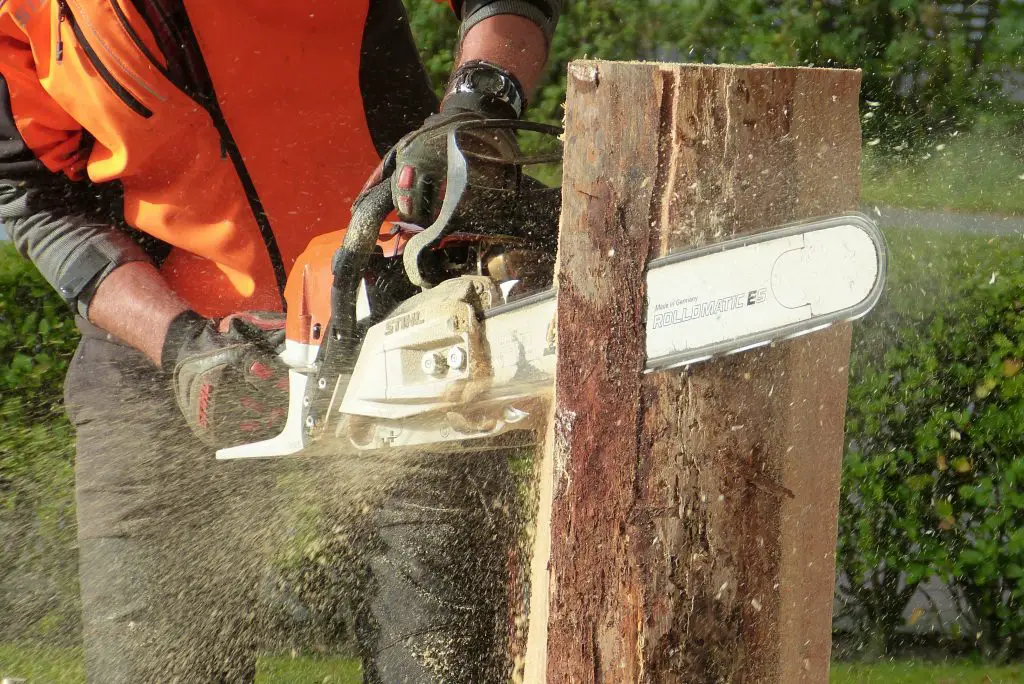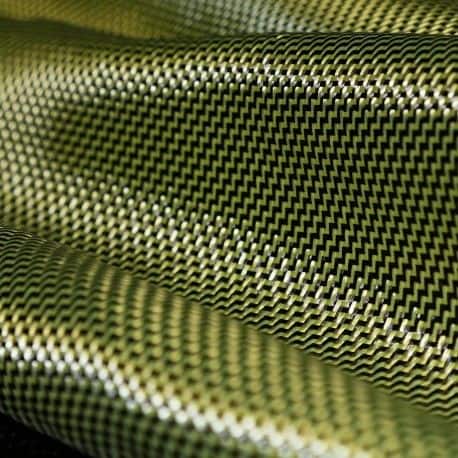Working with chainsaw is no kids play!
It can cause serious hazards to your hands including the cutting or chopping off of your hands in case your hands get stuck in the running chain of the chainsaw!
Pretty dangerous right?
Well, every danger can be beat with the right safety measure and the perfect and the most crucial PPE for working with a chainsaw is the chainsaw gloves!
Truly, there is no alternative to chainsaw gloves mostly because of working mechanism which is…
Chainsaw gloves are made of two layers; the outer layer and the inner layer. While the outer layer prevents cuts, tears and punctures, once the outer layer is exposed to a cut, the loose fibers in the inner layer explodes to block the sprocket of the chainsaw and stop it from running any further, thus preventing any accident from the chainsaw.

Still not clear about how do chainsaw gloves work?
Well, let’s read on to find in details all about chainsaw gloves…
The Mechanism of Chainsaw Gloves
Chainsaw gloves are no normal gloves. They are tough built heavy-duty gloves in order to protect you against the hazards of chainsaw and for this, they are built with multiple layers of fabric, each layer contributing to a specific function in protection.
Basically, chainsaw gloves work on the following two principles:
The outer layer of chainsaw gloves:
The outer layer of chainsaw gloves is for protecting the inner layer from any cuts, abrasions, tear and punctures. It in fact, this layer works as a shield to protect against any forms of hazards.
The inner layer of chainsaw gloves:
This layer is made of fabrics such as Kevlar, nylon and Prolar. This layer is formed of loose fibers that act in protecting your hands from the damages caused by the chain of the chainsaw.
The working principle of chainsaw gloves:
If by any chance, accidentally the chainsaw cuts through the outer layer of the chainsaw gloves, it will expose the loose fibers of the inner layer of the gloves.
The inner fibers will then automatically wrap around the drive sprocket in order to create a solid lock thus, stopping the chainsaw from running any further.
Thus, while the outer layer prevents your hands from getting cut, the inner layer reduces the severity of injury by stopping the chainsaw all together.
How long do chainsaw gloves last?
Once the chainsaw gloves have been exposed to an accident, that is once the chainsaw cuts through the outer layer of the gloves and the loose fabric of the inner layer winds up to stop the chain from running further, you must know that it’s time to replace your chainsaw gloves and buy a new pair.
What should you look for in chainsaw gloves?
You will find a variety of chainsaw gloves in the market, one exceeding in quality than the others which makes your choice for safety quite tough.
But I will tell you very definitive qualities that are actually essential to be present in a chainsaw glove for your ultimate hand protection while operating chainsaw:
-
-
- The strength and durability of the chainsaw gloves should be your first look out
- The chainsaw gloves also need to be flexible enough to allow you to operate the chainsaw flawlessly
- The chainsaw gloves should provide you a good grip of the chain
- The chainsaw gloves must be water, oil and slip resistant
- The chainsaw gloves should better be made of Hi-Viz materials so that your hands are visible while working in the dark
-
Let us now know about the materials that have the above-mentioned qualities:
The outer layer materials of chainsaw gloves
1.) Thermoplastic rubber:

This particular type of material has both the properties of rubber and plastic and therefore makes the best outer layer for chainsaw gloves while providing excellent strength, durability, cut, tear and abrasion resistance and also excellent grip while being oil and slip and water resistant.
2.) Leather:
Leather is another go-to material for chainsaw glove makers. Leather has excellent stretching properties which makes it super flexible for handling chainsaws, it is also cut and tear resistant and also provide decent grip.
3.) Goatskin:
Goatskin is often used to make the palms of chainsaw gloves because of its excellent resistance to cuts and punctures and mostly because of its ability to wick away the sweat from your palms while working.
4.) Spandex:
Spandex is used to make the back and the wrist area of the chainsaw gloves particularly because of its stretchy nature that makes putting on and off of the gloves easier and also help to provide a proper fit of the gloves.
The inner layer materials of chainsaw gloves
1.) Kevlar:

Kevlar is mostly used in the seams of the chainsaw gloves because of its cut-resistant properties and also because of its high tensile strength that provides durability and strength to the chainsaw gloves.
2.) Prolar:
This material is particularly used in the inner layer of the chainsaw gloves that explodes once in contact with the chain of the chainsaw and jams in the sprocket in order to stop the chain immediately. This is in fact, the best option for the inner layer of chainsaw gloves when safety is concerned.
3.) Nylon:
Nylon in its original form or ballistic, is used in the inner layers of chainsaw gloves for the very same purpose of stopping the chainsaw from stopping immediately when in contact.
Fitting of chainsaw gloves:
While chainsaw gloves are available in many sizes you should look for the following points while considering the proper fit of the chainsaw gloves:
-
-
- The chainsaw gloves should not be too loose as this might cause the gloves to slip off from your hands while operating the chainsaw
- The chainsaw gloves also should not be too tight to block your blood circulation and cause discomfort while working
- All in all, the chainsaw gloves should provide for a relaxed fit while still holding tight enough to your hands at the wrist area
-
What are chainsaw gloves made of?
Chainsaw gloves are made of materials such as leather, rubber, TPR (thermoplastic rubber), nylon, spandex, Kevlar, prolar, etc. All these materials ensure the proper working of the chainsaw gloves at its best by providing the following features:
-
-
- Cut resistance
- Tear and abrasion resistance
- Puncture resistance
- Waterproof
- Oil and slip resistance
- Great grip
- And exploding of the loose fabric (in case of inner layer of chainsaw gloves) to block the chain from working immediately
-
Are chainsaw gloves worth it?
Chainsaw gloves are totally worth it and there is no alternative to a chainsaw glove. This is because chainsaw gloves are built on a special mechanism that is particularly essential for handling a chainsaw.
The outer layer of chainsaw gloves prevents any cut, tear, puncture or abrasion and once the inner layer is exposed after an accident, the fibers in it immediately blocks the chain from running, thus stopping the severity of hazards.
How do you wash a chainsaw glove?
You can wash a chainsaw glove either in the washing machine in delicate cycle and without turning on the dryer or its better to wash the chainsaw gloves with your hands following the steps below:
1.) If your gloves are made of rubber or leather, take a soft bristled toothbrush and dust off the loose dirt from the outer layer of the gloves
2.) Prepare a soap-water solution using mild shampoo in a bowl
3.) Now, using the toothbrush rub the outer layer of the gloves with the soap-water solution
4.) Use a wet lint free cloth to wipe off the soap-water solution from the outer layer of the gloves
5.) Now, turn the inner side out of the gloves
6.) Wash the inner side of the gloves by dipping it in the soap solution and rubbing with your hands
7.) Again, dip the gloves in clean water to remove the soap-water solution
8.) Hang the gloves while still the inner side out under the fan
9.) Once the inner side is dry, turn the outer side of the gloves up and dry it completely too under the fan
10.) Your chainsaw gloves are super clean now!
Can you stop a chainsaw with your hands?
Like really?
Do you even want to take a chance with that?
No! you cannot and you should never stop a chainsaw with bare hands otherwise it can cost you the cutting off of your hands entirely by getting blocked in the running chain of the chainsaw.
See also: Best Hearing Protection for Chainsaw Use
And it’s a wrap!
That’s all with chainsaw gloves for today!
Just remember to choose the right material and the right fitting for a chainsaw glove to ensure maximum protection of your hands while handling the dangerous chainsaw!







